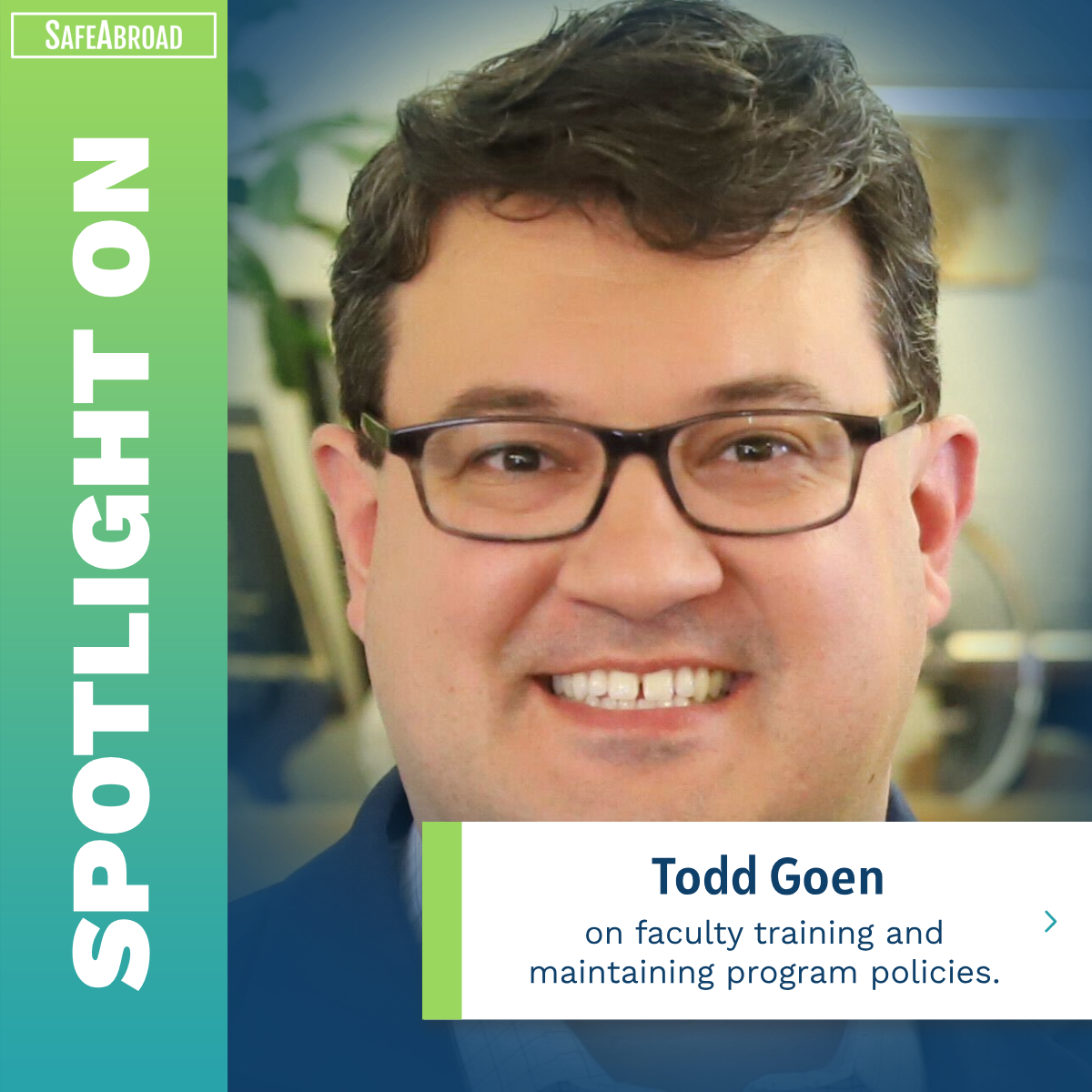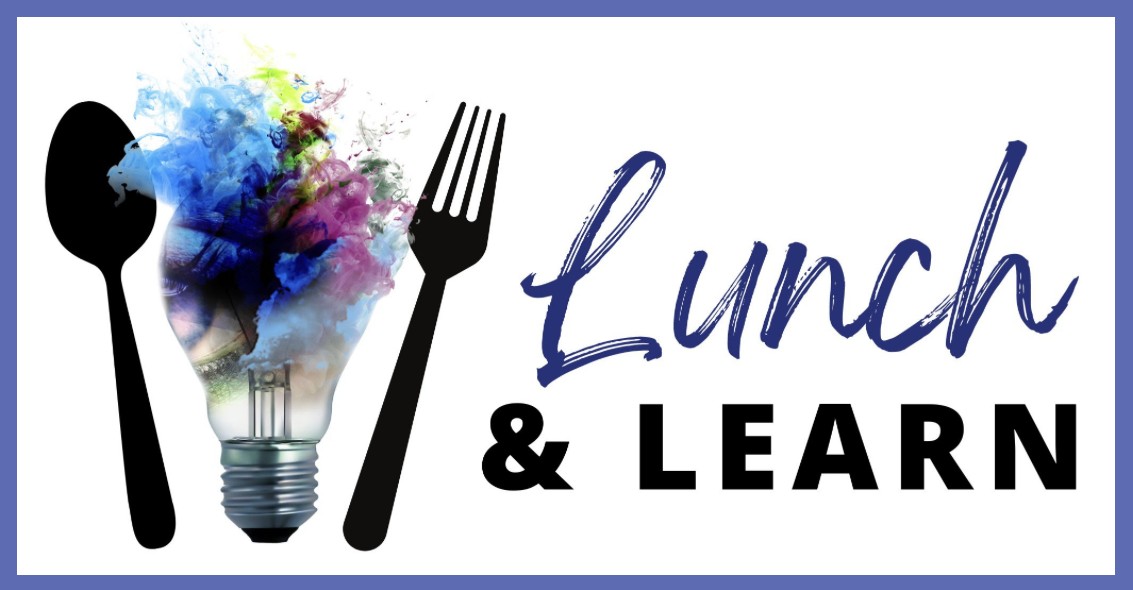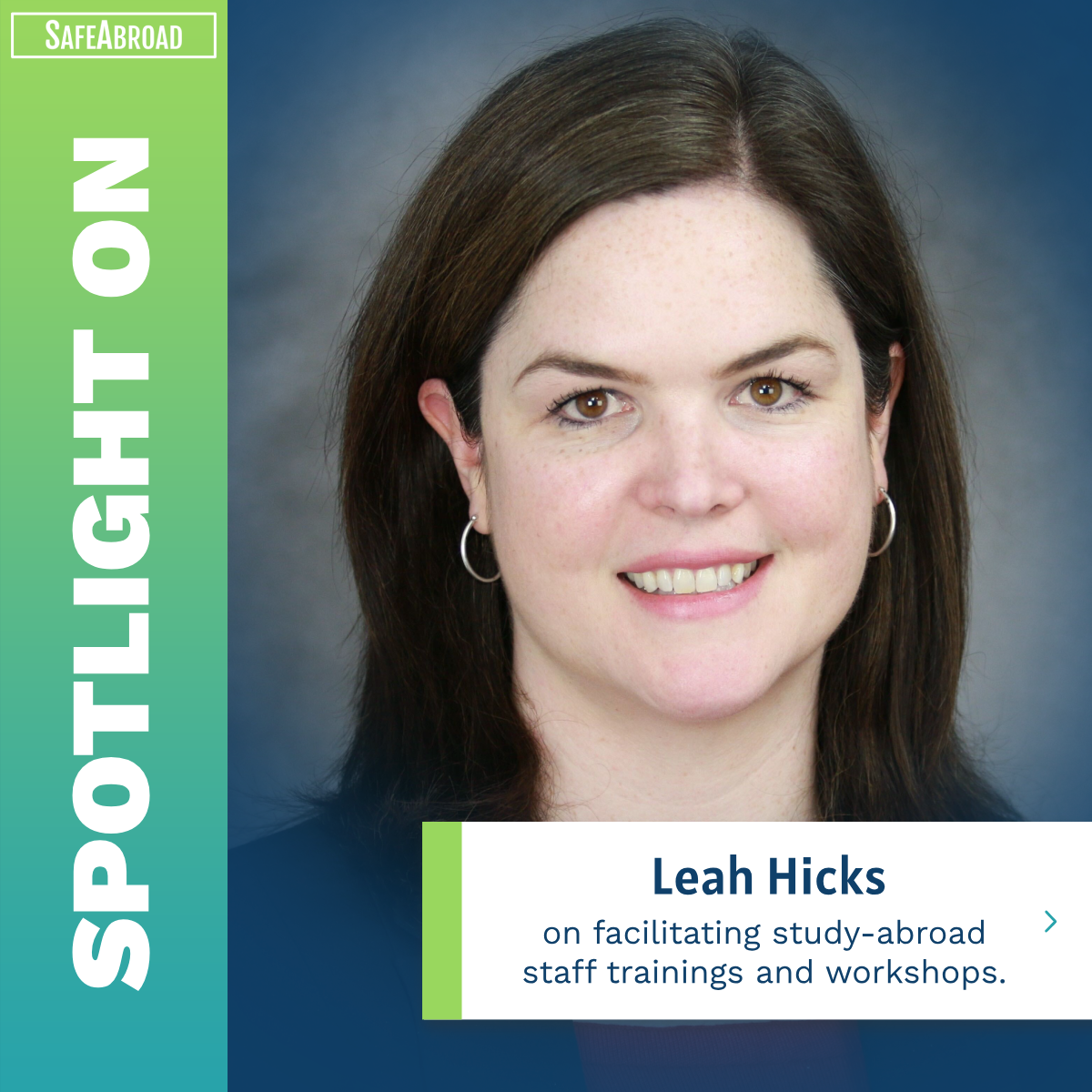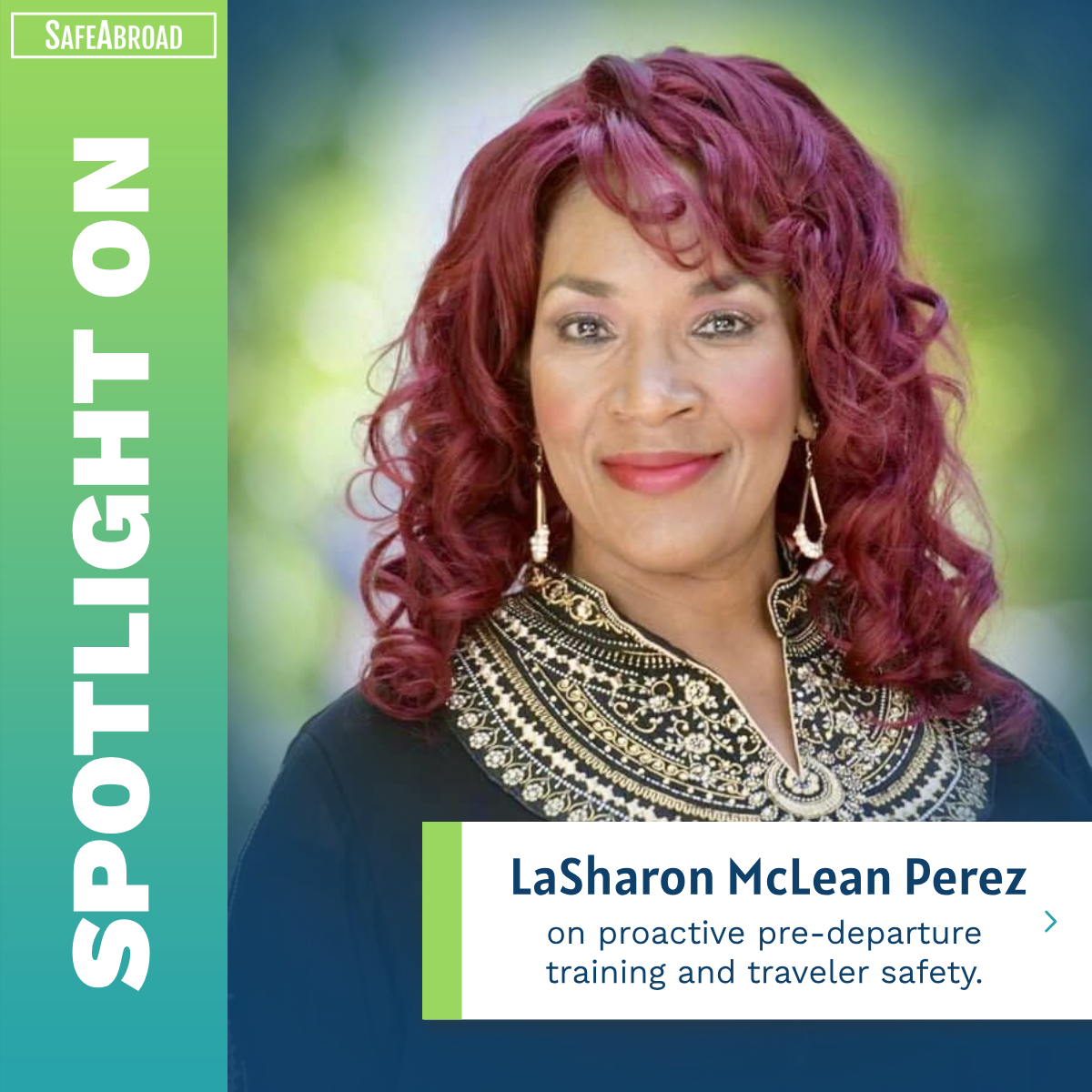What is the role of tabletop exercises in preparing faculty and staff for study abroad programs? How do these exercises simulate real-world scenarios that faculty and staff might encounter?
I think of tabletop exercises in two categories as opposed to a singular perspective. I do that because you can have formal tabletop exercises, which is what I think most people imagine – where you get a group of people around a table and sit down and walk through it, but there’s an important informal way to do tabletop exercises where you just encounter individual faculty and staff members and run ideas by them, or sometimes giving them a scenario and asking them to work through that. In terms of preparation for faculty and staff, if you’re doing any sort of training (as a lot of institutions do), you certainly need to have tabletop exercises as a part of that process; however, I think the informal pieces are oftentimes more important than formal, routinely scheduled tabletop exercises.
Those routine tabletop exercises are going to focus on what we typically see. They’re going to focus on the training piece that faculty and staff need to be able to lead programs on-site, and they provide a really good opportunity for faculty and staff to chat with each other and get feedback from each other’s experiences. I know that in my own experience as a faculty leader, some of the best insight that I got was hearing from other people who are doing the same thing. That said, it’s really the individual encounters that I have found to be the most informative, and where a lot of the growth occurs. For example, I’ll participate in a webinar, or I will have a meeting with a colleague at another institution, and someone will mention how they dealt with an incident. Then, it’s a matter of me going to individual staff members who might experience something similar and asking their process for dealing with the same situation. This gives opportunities for the faculty to be reflective, and it’s integrating a real-world scenario into the conversation.
If you’re going to do tabletop exercises, they have to be focused on the real world. Also, creating patterns where faculty and staff are routinely encouraged to think about safety and security issues or risk management proactively is always a good thing. The more that we think through these, the more that we contemplate possible scenarios, and the greater our abilities to respond in a particular situation.
What are some of the most common scenarios or challenges you include in those tabletop exercises and how do these exercises help faculty and staff improve their crisis management and decision-making skills?
There are two criteria I follow when selecting any sort of tabletop exercise for faculty and staff. First, scenarios must be grounded in reality, and second, grounded in the probability of their occurrence. That doesn’t negate the need to prepare faculty and staff for worst-case scenarios, but the probability of a worst-case scenario is significantly lower than a lot of the other scenarios that we face. Another piece of this is—when you get to those worst-case scenarios, you’re not dealing with them alone, and you’re not the sole decision maker, and you’re not managing a lot of the risk at that point as a faculty or a staff member. It’s the common scenarios that faculty and staff are more likely to face directly and on their own. Things like student behavioral issues, conduct issues, routine illnesses, etc. These are things that we can anticipate would be part of our daily life on campus, and making sure that those faculty and staff members are equipped not only to address them—because oftentimes addressing those behaviors or addressing the challenges aren’t part of their routine job at the institution—but also making sure that they understand how they would address them in a different country.
How do you measure the effectiveness of your tabletop exercises in enhancing the preparedness of faculty and staff, and do you have any specific outcomes or improvements you’ve observed?
Measurement is challenging because the true measure comes when a crisis emerges and faculty and staff members have to respond to it. In the work that we do, our goal is really to mitigate situations so we don’t get to that particular point in the process. The ultimate measure of success is: there was a crisis, let’s debrief to see if we responded appropriately, what needs to change at a procedural level or even policy level, etc. That’s the long-term metric.
There are a few shorter-term metrics we use. One of the primary metrics that I’m interested in is increased awareness. I oftentimes will measure that based on the number of conversations that folks are having and how they’re responding in those conversations. Occasionally I’ll get faculty leaders who’ll come to me with their own scenario they heard about from their colleagues at another institution or some other outside source, and that to me is a measure of success. Not only are they thinking about risk management, but they’re now coming to have a conversation with me about risk management.
At the end of the day, the primary function of a tabletop exercise is to increase awareness and to make sure that people have minimum knowledge at least of how they respond in a variety of different contexts, whether or not that actually happens. In a way, you almost hope you’re not getting enough data because that means you’re not having enough crises where you can do statistical analyses to determine your success.
How do you approach updating program policies for study abroad? What are some factors typically that prompt these changes?
There are three basic drivers for policy updates at institutions of higher education. The first is routine policy updates, meaning policies need to be reviewed on a regular cycle. In the Commonwealth of Virginia, anything that is an institutional-level policy is reviewed at a certain interval; some of them review on annual cycles, some of them review every 2 years, etc. If your institution doesn’t have some sort of review cycle for policies related to risk management for international work and you’re in charge of setting or managing those policies, you need to implement them yourself. Everything needs to be reviewed routinely. The key is making sure that everything stays up to date, and finding language that is as generic as it possibly can be so that you don’t have to continue changing it as much but simultaneously cover what it needs to cover.
The second type of policy updates are in response to changes in standard practices. For example, no one had policies that covered a global pandemic prior to a global pandemic. Now we all have something in there that covers a situation like that. And it’s not just because there was a global pandemic, but that was the catalyst where we recognized our policies are missing a piece here. So much changed in response to that one event within the context of the field. Think about organizations like the Forum on Education Abroad updating its standards. What are we doing in response to the standards update? Or oftentimes in response to State legislatures? This is where you need your network. You need to be paying attention to the industry. You need to be attending professional conferences. You need to be engaged in the conversations that are occurring in the field in terms of what’s going on from a risk management and risk assessment and crisis management perspective so that you can adapt what you’re doing to meet where the field is moving as it’s moving.
Finally, we have policy change that is in response to specific behaviors or challenges that have emerged as a result of a particular incident at an institution. If you talk to anyone who’s been in the field for any amount of time, we all have these policies, and they exist at multiple levels. Sometimes your policy exists at the program level, country level, or institutional level, and those need to be adapted as events arise.
How are you ensuring that your faculty and staff are informed and trained on those new and revised program policies?
The biggest thing for me is really about communication, and you need a communication strategy that fits within your institution and how your institution operates. I’ve been at institutions where the way that policy changes were communicated was in person at regularly scheduled meetings. I’ve also been to institutions where they were communicated via email. It really is a matter of what strategy works best for the individual institution.
I think that effective communication really requires two things. Yes, you have to convey the policy, but you also need to convey the rationale behind the policy. What you need is compliance with the new policy. There is a reason that you’re implementing the new policy, and you need to make sure that people understand that reason so that even if they disagree with the policy they are still going to comply with it and make sure that any participants in programs are complying with that policy as well. You need to communicate in whatever way works best for your institution, but you also need to make certain that you explain the rationale for it.
Can you discuss the process of evaluating and revising program policies to stay for staying relevant and effective? How do you include your faculty, staff, and stakeholders?
That’s an institution-specific question because it depends on how policy is developed and implemented at a given institution. I’ve worked at a variety of different types of institutions over my career, and I can say at some institutions faculty were the drivers of some of that policy. I’ve been in faculty roles where I chaired the committee that was the driver of setting a lot of that policy. At other institutions, the unit itself will set the policies. At some institutions, it’s a joint enterprise, and at even other institutions the policy is set by higher organizational leaders in the institution and comes down from above the unit. First, you need to know your institution and how your policies were developed. That will give you guidance in terms of how and when your policies are going to be evaluated and revised.
At a minimum, there should be some sort of evaluation that occurs every year looking to see if what we have done over the past year has worked or if there were incidents that arose that we need to manage in some way differently. Beyond that, whatever your system is, having open and honest conversations with all of those stakeholders is critical. How you do that is also going to be different based on your institution. I’ve been at institutions where we held town halls. I’ve been at institutions where we held one-on-one conversations with individual faculty or staff members. It really, again, goes back to how your institution works.
If faculty members are coming to me with a particular proposal for a policy change themselves, I’m going to take that very seriously because they’re the folks who are on the ground dealing with it. That doesn’t mean that they always get the policy change that they want, but it is something that I will consider. I actually do the same thing with students, although with students I need a bigger critical mass. In one conversation I had last year with a faculty member proposing a policy change, they made a really compelling point, but unfortunately, it didn’t fit the bigger-picture goals and functions of the institution. I had to say Todd the faculty member agrees with you, but Todd the Director of Global Education & Senior International Officer does not. On that note, I would say to some degree, it’s definitely important to look at the background of the people who are engaged in that particular policy development, whether it be from your own faculty or from above your head – understanding that will give you context for the policy concern.






